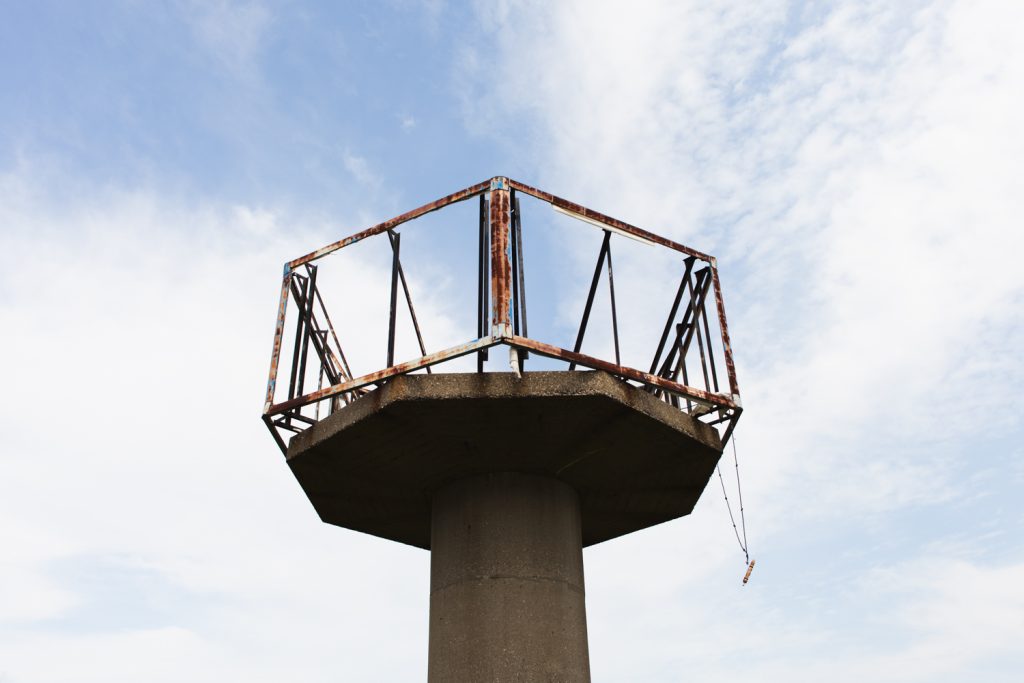Alfred Brush Ford Park’s Cold War History
Past the picnic tables and playgrounds lie two abandoned Nike Missile radar towers.

There are just a few men fishing off the edge of Alfred Brush Ford Park on a cloudy July afternoon when I stop by. Michael Williams from Detroit is sitting on a bench, watching the few poles he’s set up for the day. He says the next park over is more popular for the sport, since the parking lot is closer to the river, but he likes this space because of the quietness.
Williams says, lately, he’s been either catching green mouth bass or green grass.
“There’s a lot of individuals from Grosse Pointe that throw their cut-up grass, throw it into the river, and it generally travels down in certain areas and most of the fishermen catch it.”
A little farther down the sidewalk, Wayne Johnson holds up one of the bass he’s already caught. As the fish wiggles on the end of the line, Johnson tells me about how he comes to the park as often as he can. He says it helps him clear his mind and forget his troubles.
“I woke up like 10 minutes to three, and I couldn’t go back to sleep so right around six o’clock I got up and started putting on my clothes, and came right on down here.”
Johnson says his brother introduced him to the spot last year, and he’s been coming back ever since. As we talk, Johnson’s fishing line catches onto someone else’s. As he works to disentangle the knot, I continue on the sidewalk, towards two concrete cylinders. Each looks about 20 feet tall with look-out platforms at the top.
A nearby fisherman describes them as “cold war silos.” I open Google Maps on my phone and see where I’m standing listed as: Nike Missile Control Site D-23.
“Airplanes got higher and faster, and guns didn’t improve that much, so they decided they’d have to use guided missiles, and hence the Nike series of missile systems”
That’s Ed Thelan, a Nike Missile historian who used to work on missile radar systems in Texas and Illinois. He says the site at Alfred Brush Ford Park served as a radar installation for missiles stored underground on Belle Isle.
Nike Historical Society treasurer Ron Parshall says, though the space is now a public park, when the station was up and running in the 1950’s, its location wasn’t widely known.
“Because of the guarded status of it, it was hard to go into town, because you’re not supposed to talk to the people, not supposed to tell them what you’re doing”
But the secrecy didn’t last too long. The station was built in the early 1950’s, and though the towers are still around, Ed Thelan says it closed in the 70’s as Intercontinental Ballistic Missiles–or I-C-B-M’s–became a greater threat.
“ICBM comes in at something like five to seven miles per second, and this equipment just can’t handle that speed. They’re good for high altitude airplanes, and really there’s no general approach to defending missiles.”
And so the Nike Missile system quickly came to an end. Thelan says, of all the stations across the country, not one fired a single missile at an enemy. Many sites have been completely cleared, but a few others have turned into parks.
Some of the fishermen at Alfred Brush Ford Park seemed to know basic details about the area’s history, but many families picnicking at the park are oblivious to the radar towers. Which, perhaps, is how the project was meant to be. There are no markings on the structures and no signs to describe their history. The secrecy the military maintained when the towers were active has continued, intentionally or not.
